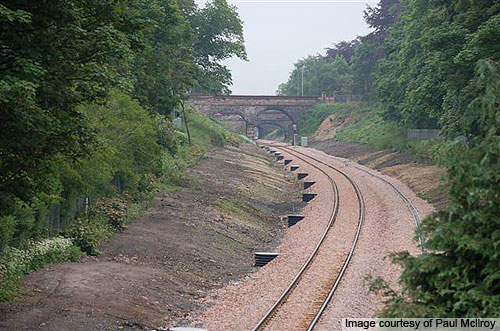The Stirling-Alloa-Kincardine (SAK) project is one of the most important railway infrastructure projects witnessed in Scotland in the past 42 years.
The project involved the re-opening of a 21km long existing, disused and abandoned railway line between Stirling Station and Longannet Power Station in Kincardine which was closed in 1968. Estimated at £57.6m, the project was jointly funded by Scottish Government, Clackmannanshire Council, Scottish Enterprise Forth Valley, Network Rail and EWS Ltd.
Construction of the railway line began in September 2005. It was completed and commissioned in March 2008 for both passenger and freight services. It is currently being operated by the state owned Network Rail.
Re-opening of the route has resulted in Alloa Station now being connected to the national rail network for the first time since 1968. The new line operates an hourly direct passenger service between Alloa, Sterling and Glasgow Queen Street stations allowing passengers to change at Sterling for further travel to Edinburgh Waverly Station. The current travel time between Alloa and Sterling is 10 minutes.
The re-opening has reduced the freight rail traffic on the Forth Rail Bridge, resulting in better passenger services on the Fife-Edinburgh rail line.
The project has also benefited the freight line from Aryshire in West of Scotland to Longannet Power Station in Fife by enabling the transport of coal to be much faster and more efficient between the two destinations. As more freight is shifted from road to rail, it has considerably reduced traffic congestion on the roads and the Forth Bridge.
In addition, the project has also improved the economic and social life of people living in the region.
Background
The re-opened line forms part of the former Stirling-Dunfermline Railway between Stirling and Alloa, and the Kincardine Line between Alloa and Dunfermline. The line was operated along the north shore of the River Forth after the Longannet Power Station. The entire route was constructed in phases between the 1840s and 1890s.
These lines were closed, after operating for a period of 90 years, in 1968 due to the advent of interstate highways.
Project development
The project was promoted by the Clackmannanshire Council and was managed by the Transport of Scotland. The construction works were carried out by a joint venture of UK based construction firms First Engineering (now known as Bobcock Rail) and Edmund Nuttal. Site supervision was carried out by the engineering firm Jacobs Babtie.
Other parties involved in the development of the project were the Scottish Government, Scottish Enterprise Firth Valley, the Strategic Rail Authority, Fife Council and Stirling Council.
Construction
The re-opening of the Stirling-Alloa-Kincardine line involved the laying of new tracks, installation of signalling systems, and construction of new level crossings and a new station building at Alloa Town Centre.
A single track was laid using conventional construction machinery. Rails measuring 60ft long were brought to the nearest point and then taken to the final position. They were fixed using mobile flash butt welding machines.
Waterproofing and soil reinforcing membranes were also used beneath the ballast along the newly constructed drainage. A bridge was renovated above A907 at Helensfield. A new abutment was also created to widen the road.
The original loop at Kincardine was removed and placed east of the junction to provide better alignment. A new turn-around facility for locomotives is also made available in the yard which is currently used as a coal loading point.
Most of the level crossings on the route were abolished except for at a few places where it was difficult and expensive to provide alternate access.
A new Alloa Eastern Link Road was also built to divert the traffic from the Alloa Town centre and allow closure of Hilton Road.
Infrastructure
The new Alloa station features a modern sheltered area made of glass and steel. It is unmanned and is fully accessible to passengers with less mobility.
Rolling stock
The passenger and freight trains travel at a top speed of 112km/h and 100km/h respectively between Alloa and Stirling stations. The speed is reduced to 48km/h between Alloa Station and Longannet Power Station.
Future expansion
Re-opening of the Dunfermline to Kincardine line was considered in February 2010 by the South East of Scotland Transport Partnership (SEStran). Engineering consultant Scott Wilson prepared a report with various route options.
It is estimated to cost £65m. The project has, however, not yet been listed in the Scottish Government Funding.










